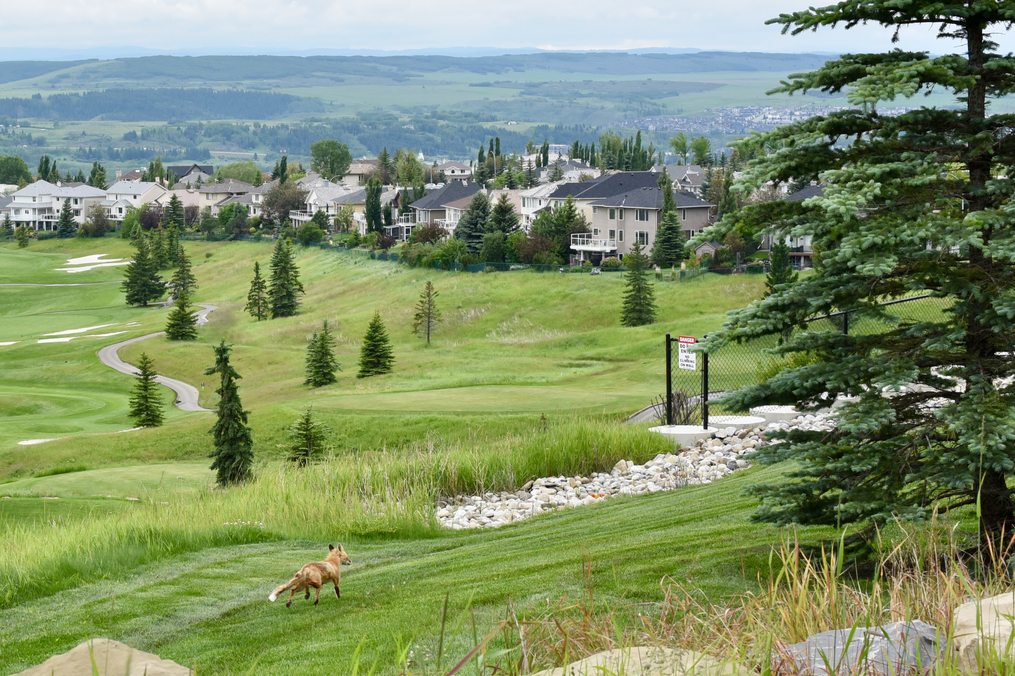Support strong Canadian climate journalism for 2025
Driving into the lush foothills of southern Alberta with the snow-capped mountains on the horizon, it isn’t hard to see what has people flocking to the beautiful town of Cochrane — close to the city, where you can raise your family with a backyard and that small-town feel.
But the vast growth of bedroom communities surrounding bigger cities in Alberta is undermining efforts to mitigate urban sprawl and carbon emissions in urban centres.
“It’s massive, massive expansion,” said Sasha Tsenkova, a professor of planning and international development in the Faculty of Environmental Design at the University of Calgary.
“What is being achieved in terms of sustainable development in the city proper is completely wiped out as an impact on the environment by these kinds of peripheral developments.”
Tsenkova said this is a problem across North America because there is so much land on which to sprawl.
The bedroom, commuter communities boom
For years, Cochrane has been a source of fascination for its insanely rapid growth rates. The 1969 municipal census pegged the village’s population at 900. The most recent count totalled 29,277.
That growth rate rocketed to 47.1 per cent between 2011 and 2016, according to Statistics Canada, the second-fastest in the country, behind Warman, Sask., just north of Saskatoon.
If Cochrane or Warman were isolated cases, it would be one thing, but they aren’t. Airdrie, just north of Calgary, grew by 42.3 per cent in the same period. Chestermere, just east, grew by 34.2 per cent. Four communities surrounding Edmonton grew in excess of 20 per cent.
Cochrane Mayor Jeff Genung guesses that the town was almost fully composed of single-family homes until about 2007, and even then, the number of multi-family units — whether they are condos or townhouses — makes up less than 10 per cent of the town.
But the sprawl associated with single-family homes is a problem when it comes to climate action.
“Council's working with administration on a community vision and one of the aspirations of that is to drive more density into our core,” Genung said. “We don't want to continue to grow outward and continue to take up countryside. We're actually trying to preserve that buffer.”

One of the biggest issues with sprawl is that people end up living further from work, school and other activities.
According to the latest data, which is from 2011, 65,131 commuters travelled into the city from the surrounding region, on average, every weekday. Over the decade prior, the number of commuters from the region increased by 32 per cent. That number will have certainly grown since, given that the population of the region boomed after 2011.
Even up to 2011, the study of regional traffic found fewer people were walking to work in Calgary because a smaller percentage of people lived close enough to the downtown. Two-thirds of people in the regions were commuting into Calgary for work and principally, that commute is made by car.
To begin addressing this issue, regional transit busses have serviced the Calgary region since 2016. In Cochrane, they’re also focusing on increasing job numbers so not as many residents need to make the drive into Calgary each day.
“The hope is that we will generate more jobs and reduce the amount of people that need to commute back and forth because they’ll actually work here,” said Dave Devana, Cochrane’s chief administrative officer.

Meanwhile, Genung and Devana are still hopeful the provincial government will invest in a regional rail transport that would connect the Calgary airport with the downtown, Cochrane and Banff.
“So, get auto traffic off of the highways, which would reduce, obviously, all those greenhouse gas emissions, but also lessen the load for the province to now have to step in with all this infrastructure money to build bigger highways,” Genung said.
A price tag for such a project has been pegged at roughly $660 million.
'How is it even possible that for 50 years we’ve become so comfortable with sprawl?'
The original issue Tsenkova raised was that any efforts by the big cities to rein in their own urban sprawl is now being wiped out. The growth of the commuter communities puts pressure on Calgary city planners because if they offer fewer single-family homes and focus on densification, they have to face the fact people may just move out of the city limits.
“It is a tricky dynamic,” said Chris Blaschuk, manager of the City of Calgary’s Next 20 project, which is reviewing the municipal development and transportation plans. “(Demand for) our semi-detached and our (multi-unit dwellings) is increasing faster than single-family homes, so the demand to shift to those types of dwellings in the city is increasing slightly.”
Last summer, Calgary city council approved 14 new suburban communities for development, adding more than 18,000 single-family homes and only half as many multi-family units.
Regional growth plans are in the works, but these constraints are non-binding. Cochrane is planning for four per cent growth annually. That would put its population just over 45,000 by 2030.
The City of Calgary’s climate change manager, Dick Ebersohn, says these growth models are calculated in the city’s emissions-reduction models.
“It is very challenging and I think collaboration in the future is going to be really important,” Ebersohn said.
Tsenkova says this alarming trend must be reversed if climate action is to be taken seriously.
“In North America in general, development patterns are surprisingly well-entrenched. And if you think about it, it wasn’t until the ’50s and early ’60s when suburban development started in earnest. So, how is it even possible that for 50 years we’ve become so comfortable with sprawl? It’s mind-boggling!”
Tsenkova went on to say that the quintessential image of what people strive for needs to change, and that need not mean personal sacrifice, simply a reimagining of how we live, work and play.
“The climate change imperative will require leaders to rethink all of this,” Tsenkova said. “And it’s not just about the newly built, it’s about retrofitting what we have.”






Comments
Sad example of authoritarian thinking in the last paragraph. It's not "our leaders" who need to re-think everything. They'd be out of office in a year if they attempted to impose major new societal structures and attitudes. It's everybody who has to re-think what the good life is.
It is very good that this crucial climate issue is being covered. But it is essential to focus on what policies drive automobile dependent sprawl. As I have written in several National Observer articles, it is federal and provincial and municipal road and highway expansion that is the biggest subsidy to sprawl. (PS. rail transit service to the airport would further subsidize air travel, and is hardly likely to reduce GHG pollution).
e.g. "Like the oil and gas sector, direct and indirect government subsidies have driven up transportation GHG pollution levels. The Canadian government reports a 43 per cent increase in GHG pollution from transportation between 1990 and 2017.
The biggest driver of increased GHG pollution in transportation has been government spending on road and highway expansion in and near urban areas. Governments understand full well that expanding highways results in more traffic and climate pollution. The 2016 Pan-Canadian Framework on Clean Growth and Climate Change (the federal-provincial climate agreement) already commits the federal and provincial governments to shift spending away from things that increase carbon pollution, such as urban highways and airport expansion, to low-carbon transportation including public transit, walking and cycling. However, both federal and provincial governments are largely ignoring this commitment." https://www.nationalobserver.com/2019/05/18/opinion/green-new-deal-must…
I'd advise cities to build up not out. A certain population density stimulates local and neighborhood economies, community interaction and events. As a grandson of a pioneer Southern Alberta farmer, I hate to see good agriculture land being converted to housing. I'd say the same about good forest land.
Urbanizing the suburbs is key to countering sprawl, and that is best accomplished with rail as the central consideration. Electrifying these and other public transit initiatives is an important step to lowering the per capita emissions of commuters, and Alberta presents a viable wind power option within its electrical grid that counters the unfortunate legacy of coal-fired generating plants.
Most Canadian cities do not have a decent commuter rail service, with the exception of Go Transit in the Greater Toronto Area, one line in Metro Vancouver (West Coast Express), and other options in Montreal. Rail will stimulate denser urban development, especially within walking distance of stations, and bring in new jobs.
I suggest that rail-urbanization proposals be treated as separate parts that coalesce under one planning effort for individual projects within an official town plan, and that an urban design phase be proposed to foster human scale streetscapes, very attractive public spaces such as town squares and outdoor performance areas, materials palettes for streets that reflect Cochrane's railway heritage, public art and so forth. Converting existing auto-oriented malls into rapid transit-oriented town centres on the way to Cochrane is also a desirable option.
Having lived in Calgary for 22 years with much admiration for Cochrane, I think carefully-designed low and mid-rise buildings would work in the core to foster mixed uses and bring office and commercial-retail jobs closer to home, offer newer live-work, light industrial and ground-oriented rowhouses and townhouses in the second ring, and help create a walkable community. As Cochrane continues to grow, light rail trams or electric trolley buses could circulate around town and connect with Cochrane Station at the centre as a regular shuttle service.
With these ideas there is the distinct possibility that people who currently live in Cochrane and commute to Calgary would be presented with the possibility of switching jobs to work only in Cochrane and eliminate the long commute. One could then consider giving up a car with the effect of increasing the level of disposable income in the family budget.
How can this not be a win-win?
In addition to urbanizing the suburbs cities like Calgary must also consider food security and greenbelts to contain sprawl and increase local agriculture. A head of lettuce grown within 20 kilometres of an urban market is far, far more advantageous than a head of lettuce shipped 2,500 kilometres. Greenbelts near cities must be part of the regional planning effort in Canada, and it could also be considered as a vital step to building resiliency in the effort to lower emissions, fight climate change and preserve natural habitat.
One could suggest that agricultural practices like conservation tillage and cover crops to build the soil, and designating land for infrastructure such as solar-heated greenhouses and wind power towers should be part of the plan.